Observational Studies: Effectiveness of YDAC Program on Youth Crime
VerifiedAdded on 2023/01/11
|10
|2637
|66
Report
AI Summary
This report presents an observational study on the effectiveness of the Youth Drug and Alcohol (YDAC) program in reducing offending among young Indigenous Australians. The study employs a quasi-experimental design, comparing offenders who participated in the YDAC program with those who did not. The research design, data collection methods (including questionnaires and interviews), and ethical considerations are discussed. The report highlights the importance of diversionary programs in preventing youthful offenders from entering the criminal justice system. The study examines the effectiveness of the YDAC program, particularly in the context of increasing youth offending rates in Australia. The report also addresses the ethical considerations involved in conducting research with vulnerable populations, such as ensuring confidentiality and obtaining informed consent. The findings aim to evaluate the impact of the YDAC program on reducing offending behaviors and provide insights into the broader effectiveness of diversionary strategies in addressing youth crime.

Observational Studies
Paraphrase This Document
Need a fresh take? Get an instant paraphrase of this document with our AI Paraphraser

Table of Contents
INTRODUCTION...........................................................................................................................1
MAIN BODY...................................................................................................................................1
Research design......................................................................................................................1
Data collection methods.........................................................................................................4
CONCLUSION................................................................................................................................5
REFERENCES................................................................................................................................2
INTRODUCTION...........................................................................................................................1
MAIN BODY...................................................................................................................................1
Research design......................................................................................................................1
Data collection methods.........................................................................................................4
CONCLUSION................................................................................................................................5
REFERENCES................................................................................................................................2
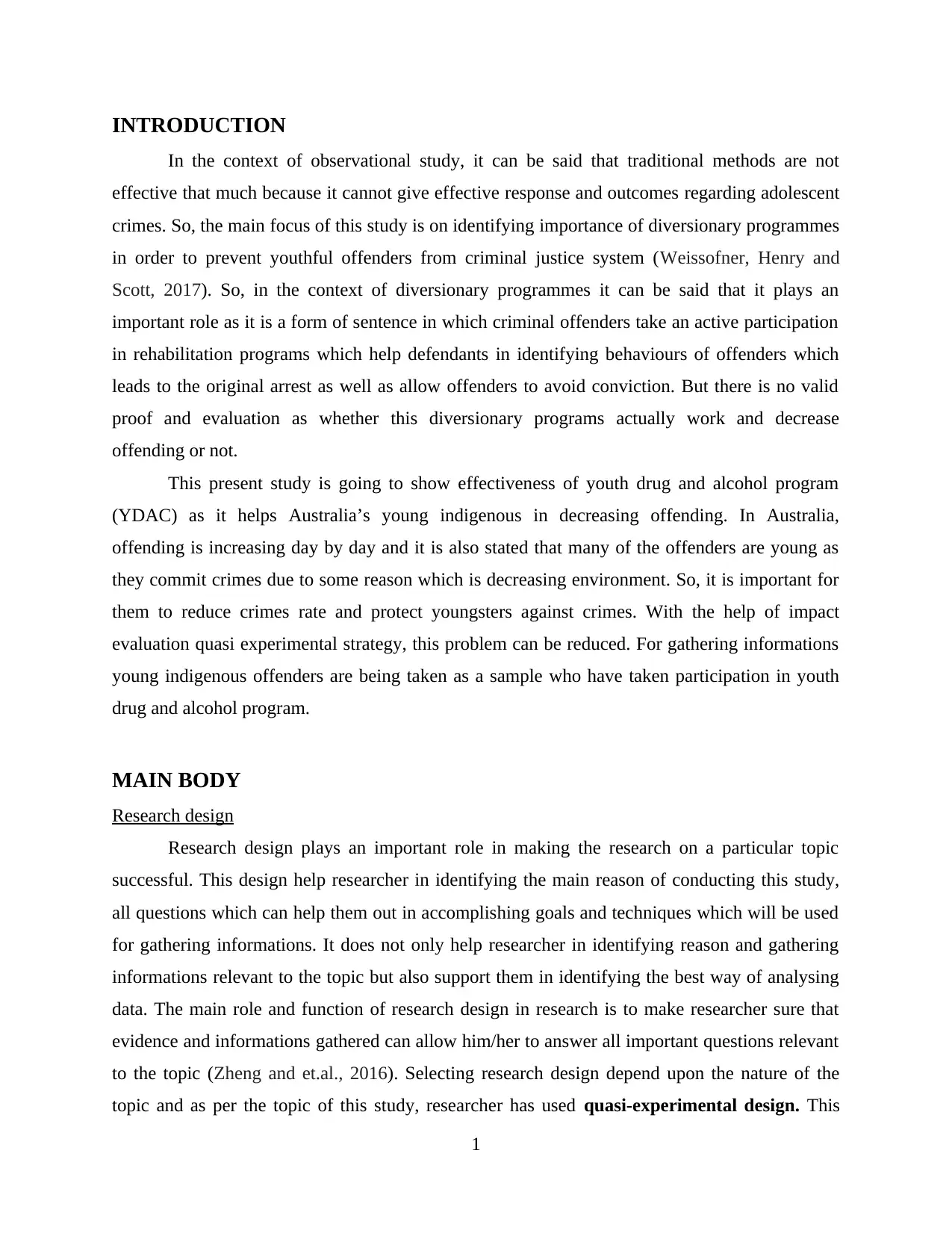
INTRODUCTION
In the context of observational study, it can be said that traditional methods are not
effective that much because it cannot give effective response and outcomes regarding adolescent
crimes. So, the main focus of this study is on identifying importance of diversionary programmes
in order to prevent youthful offenders from criminal justice system (Weissofner, Henry and
Scott, 2017). So, in the context of diversionary programmes it can be said that it plays an
important role as it is a form of sentence in which criminal offenders take an active participation
in rehabilitation programs which help defendants in identifying behaviours of offenders which
leads to the original arrest as well as allow offenders to avoid conviction. But there is no valid
proof and evaluation as whether this diversionary programs actually work and decrease
offending or not.
This present study is going to show effectiveness of youth drug and alcohol program
(YDAC) as it helps Australia’s young indigenous in decreasing offending. In Australia,
offending is increasing day by day and it is also stated that many of the offenders are young as
they commit crimes due to some reason which is decreasing environment. So, it is important for
them to reduce crimes rate and protect youngsters against crimes. With the help of impact
evaluation quasi experimental strategy, this problem can be reduced. For gathering informations
young indigenous offenders are being taken as a sample who have taken participation in youth
drug and alcohol program.
MAIN BODY
Research design
Research design plays an important role in making the research on a particular topic
successful. This design help researcher in identifying the main reason of conducting this study,
all questions which can help them out in accomplishing goals and techniques which will be used
for gathering informations. It does not only help researcher in identifying reason and gathering
informations relevant to the topic but also support them in identifying the best way of analysing
data. The main role and function of research design in research is to make researcher sure that
evidence and informations gathered can allow him/her to answer all important questions relevant
to the topic (Zheng and et.al., 2016). Selecting research design depend upon the nature of the
topic and as per the topic of this study, researcher has used quasi-experimental design. This
1
In the context of observational study, it can be said that traditional methods are not
effective that much because it cannot give effective response and outcomes regarding adolescent
crimes. So, the main focus of this study is on identifying importance of diversionary programmes
in order to prevent youthful offenders from criminal justice system (Weissofner, Henry and
Scott, 2017). So, in the context of diversionary programmes it can be said that it plays an
important role as it is a form of sentence in which criminal offenders take an active participation
in rehabilitation programs which help defendants in identifying behaviours of offenders which
leads to the original arrest as well as allow offenders to avoid conviction. But there is no valid
proof and evaluation as whether this diversionary programs actually work and decrease
offending or not.
This present study is going to show effectiveness of youth drug and alcohol program
(YDAC) as it helps Australia’s young indigenous in decreasing offending. In Australia,
offending is increasing day by day and it is also stated that many of the offenders are young as
they commit crimes due to some reason which is decreasing environment. So, it is important for
them to reduce crimes rate and protect youngsters against crimes. With the help of impact
evaluation quasi experimental strategy, this problem can be reduced. For gathering informations
young indigenous offenders are being taken as a sample who have taken participation in youth
drug and alcohol program.
MAIN BODY
Research design
Research design plays an important role in making the research on a particular topic
successful. This design help researcher in identifying the main reason of conducting this study,
all questions which can help them out in accomplishing goals and techniques which will be used
for gathering informations. It does not only help researcher in identifying reason and gathering
informations relevant to the topic but also support them in identifying the best way of analysing
data. The main role and function of research design in research is to make researcher sure that
evidence and informations gathered can allow him/her to answer all important questions relevant
to the topic (Zheng and et.al., 2016). Selecting research design depend upon the nature of the
topic and as per the topic of this study, researcher has used quasi-experimental design. This
1
⊘ This is a preview!⊘
Do you want full access?
Subscribe today to unlock all pages.

Trusted by 1+ million students worldwide
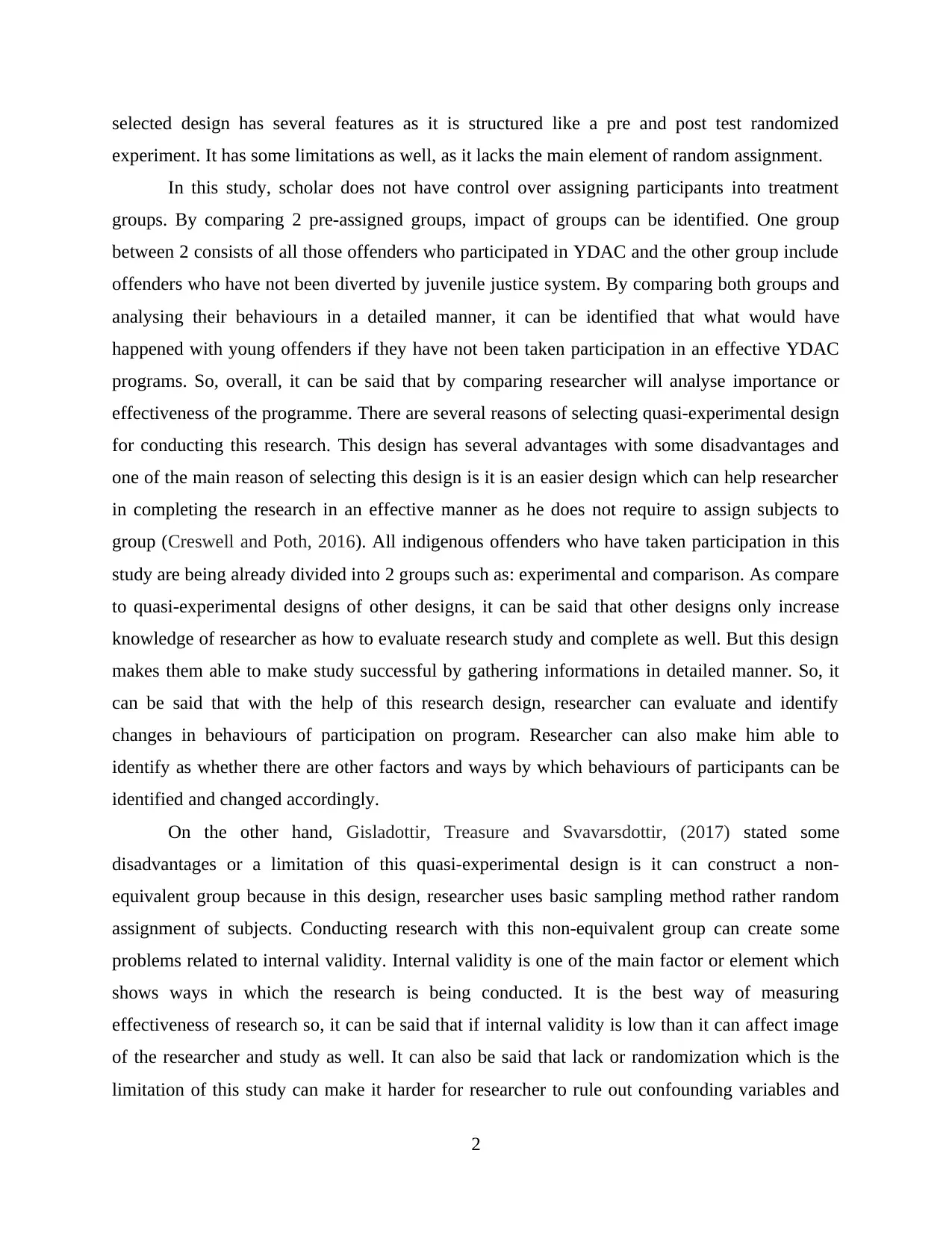
selected design has several features as it is structured like a pre and post test randomized
experiment. It has some limitations as well, as it lacks the main element of random assignment.
In this study, scholar does not have control over assigning participants into treatment
groups. By comparing 2 pre-assigned groups, impact of groups can be identified. One group
between 2 consists of all those offenders who participated in YDAC and the other group include
offenders who have not been diverted by juvenile justice system. By comparing both groups and
analysing their behaviours in a detailed manner, it can be identified that what would have
happened with young offenders if they have not been taken participation in an effective YDAC
programs. So, overall, it can be said that by comparing researcher will analyse importance or
effectiveness of the programme. There are several reasons of selecting quasi-experimental design
for conducting this research. This design has several advantages with some disadvantages and
one of the main reason of selecting this design is it is an easier design which can help researcher
in completing the research in an effective manner as he does not require to assign subjects to
group (Creswell and Poth, 2016). All indigenous offenders who have taken participation in this
study are being already divided into 2 groups such as: experimental and comparison. As compare
to quasi-experimental designs of other designs, it can be said that other designs only increase
knowledge of researcher as how to evaluate research study and complete as well. But this design
makes them able to make study successful by gathering informations in detailed manner. So, it
can be said that with the help of this research design, researcher can evaluate and identify
changes in behaviours of participation on program. Researcher can also make him able to
identify as whether there are other factors and ways by which behaviours of participants can be
identified and changed accordingly.
On the other hand, Gisladottir, Treasure and Svavarsdottir, (2017) stated some
disadvantages or a limitation of this quasi-experimental design is it can construct a non-
equivalent group because in this design, researcher uses basic sampling method rather random
assignment of subjects. Conducting research with this non-equivalent group can create some
problems related to internal validity. Internal validity is one of the main factor or element which
shows ways in which the research is being conducted. It is the best way of measuring
effectiveness of research so, it can be said that if internal validity is low than it can affect image
of the researcher and study as well. It can also be said that lack or randomization which is the
limitation of this study can make it harder for researcher to rule out confounding variables and
2
experiment. It has some limitations as well, as it lacks the main element of random assignment.
In this study, scholar does not have control over assigning participants into treatment
groups. By comparing 2 pre-assigned groups, impact of groups can be identified. One group
between 2 consists of all those offenders who participated in YDAC and the other group include
offenders who have not been diverted by juvenile justice system. By comparing both groups and
analysing their behaviours in a detailed manner, it can be identified that what would have
happened with young offenders if they have not been taken participation in an effective YDAC
programs. So, overall, it can be said that by comparing researcher will analyse importance or
effectiveness of the programme. There are several reasons of selecting quasi-experimental design
for conducting this research. This design has several advantages with some disadvantages and
one of the main reason of selecting this design is it is an easier design which can help researcher
in completing the research in an effective manner as he does not require to assign subjects to
group (Creswell and Poth, 2016). All indigenous offenders who have taken participation in this
study are being already divided into 2 groups such as: experimental and comparison. As compare
to quasi-experimental designs of other designs, it can be said that other designs only increase
knowledge of researcher as how to evaluate research study and complete as well. But this design
makes them able to make study successful by gathering informations in detailed manner. So, it
can be said that with the help of this research design, researcher can evaluate and identify
changes in behaviours of participation on program. Researcher can also make him able to
identify as whether there are other factors and ways by which behaviours of participants can be
identified and changed accordingly.
On the other hand, Gisladottir, Treasure and Svavarsdottir, (2017) stated some
disadvantages or a limitation of this quasi-experimental design is it can construct a non-
equivalent group because in this design, researcher uses basic sampling method rather random
assignment of subjects. Conducting research with this non-equivalent group can create some
problems related to internal validity. Internal validity is one of the main factor or element which
shows ways in which the research is being conducted. It is the best way of measuring
effectiveness of research so, it can be said that if internal validity is low than it can affect image
of the researcher and study as well. It can also be said that lack or randomization which is the
limitation of this study can make it harder for researcher to rule out confounding variables and
2
Paraphrase This Document
Need a fresh take? Get an instant paraphrase of this document with our AI Paraphraser
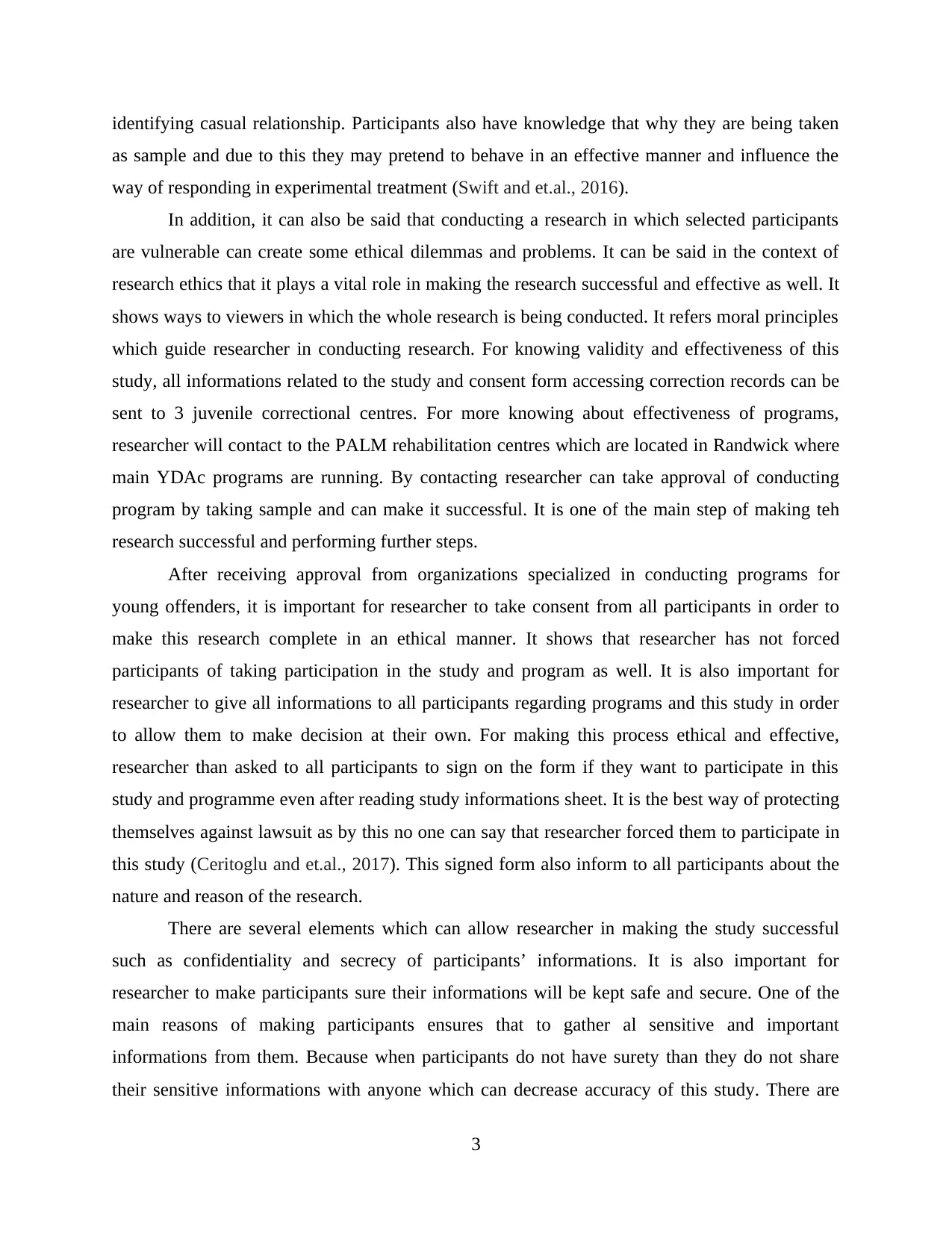
identifying casual relationship. Participants also have knowledge that why they are being taken
as sample and due to this they may pretend to behave in an effective manner and influence the
way of responding in experimental treatment (Swift and et.al., 2016).
In addition, it can also be said that conducting a research in which selected participants
are vulnerable can create some ethical dilemmas and problems. It can be said in the context of
research ethics that it plays a vital role in making the research successful and effective as well. It
shows ways to viewers in which the whole research is being conducted. It refers moral principles
which guide researcher in conducting research. For knowing validity and effectiveness of this
study, all informations related to the study and consent form accessing correction records can be
sent to 3 juvenile correctional centres. For more knowing about effectiveness of programs,
researcher will contact to the PALM rehabilitation centres which are located in Randwick where
main YDAc programs are running. By contacting researcher can take approval of conducting
program by taking sample and can make it successful. It is one of the main step of making teh
research successful and performing further steps.
After receiving approval from organizations specialized in conducting programs for
young offenders, it is important for researcher to take consent from all participants in order to
make this research complete in an ethical manner. It shows that researcher has not forced
participants of taking participation in the study and program as well. It is also important for
researcher to give all informations to all participants regarding programs and this study in order
to allow them to make decision at their own. For making this process ethical and effective,
researcher than asked to all participants to sign on the form if they want to participate in this
study and programme even after reading study informations sheet. It is the best way of protecting
themselves against lawsuit as by this no one can say that researcher forced them to participate in
this study (Ceritoglu and et.al., 2017). This signed form also inform to all participants about the
nature and reason of the research.
There are several elements which can allow researcher in making the study successful
such as confidentiality and secrecy of participants’ informations. It is also important for
researcher to make participants sure their informations will be kept safe and secure. One of the
main reasons of making participants ensures that to gather al sensitive and important
informations from them. Because when participants do not have surety than they do not share
their sensitive informations with anyone which can decrease accuracy of this study. There are
3
as sample and due to this they may pretend to behave in an effective manner and influence the
way of responding in experimental treatment (Swift and et.al., 2016).
In addition, it can also be said that conducting a research in which selected participants
are vulnerable can create some ethical dilemmas and problems. It can be said in the context of
research ethics that it plays a vital role in making the research successful and effective as well. It
shows ways to viewers in which the whole research is being conducted. It refers moral principles
which guide researcher in conducting research. For knowing validity and effectiveness of this
study, all informations related to the study and consent form accessing correction records can be
sent to 3 juvenile correctional centres. For more knowing about effectiveness of programs,
researcher will contact to the PALM rehabilitation centres which are located in Randwick where
main YDAc programs are running. By contacting researcher can take approval of conducting
program by taking sample and can make it successful. It is one of the main step of making teh
research successful and performing further steps.
After receiving approval from organizations specialized in conducting programs for
young offenders, it is important for researcher to take consent from all participants in order to
make this research complete in an ethical manner. It shows that researcher has not forced
participants of taking participation in the study and program as well. It is also important for
researcher to give all informations to all participants regarding programs and this study in order
to allow them to make decision at their own. For making this process ethical and effective,
researcher than asked to all participants to sign on the form if they want to participate in this
study and programme even after reading study informations sheet. It is the best way of protecting
themselves against lawsuit as by this no one can say that researcher forced them to participate in
this study (Ceritoglu and et.al., 2017). This signed form also inform to all participants about the
nature and reason of the research.
There are several elements which can allow researcher in making the study successful
such as confidentiality and secrecy of participants’ informations. It is also important for
researcher to make participants sure their informations will be kept safe and secure. One of the
main reasons of making participants ensures that to gather al sensitive and important
informations from them. Because when participants do not have surety than they do not share
their sensitive informations with anyone which can decrease accuracy of this study. There are
3
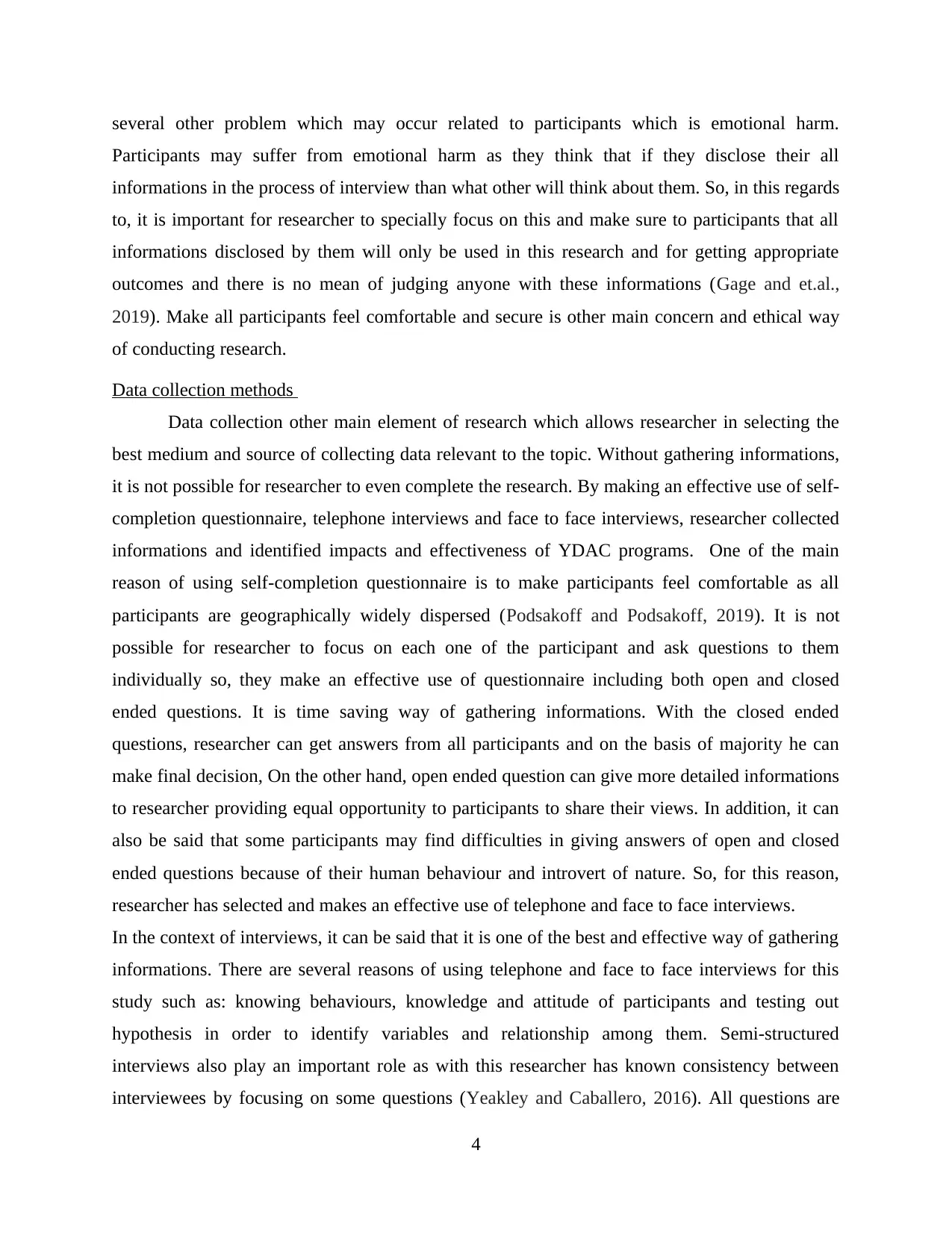
several other problem which may occur related to participants which is emotional harm.
Participants may suffer from emotional harm as they think that if they disclose their all
informations in the process of interview than what other will think about them. So, in this regards
to, it is important for researcher to specially focus on this and make sure to participants that all
informations disclosed by them will only be used in this research and for getting appropriate
outcomes and there is no mean of judging anyone with these informations (Gage and et.al.,
2019). Make all participants feel comfortable and secure is other main concern and ethical way
of conducting research.
Data collection methods
Data collection other main element of research which allows researcher in selecting the
best medium and source of collecting data relevant to the topic. Without gathering informations,
it is not possible for researcher to even complete the research. By making an effective use of self-
completion questionnaire, telephone interviews and face to face interviews, researcher collected
informations and identified impacts and effectiveness of YDAC programs. One of the main
reason of using self-completion questionnaire is to make participants feel comfortable as all
participants are geographically widely dispersed (Podsakoff and Podsakoff, 2019). It is not
possible for researcher to focus on each one of the participant and ask questions to them
individually so, they make an effective use of questionnaire including both open and closed
ended questions. It is time saving way of gathering informations. With the closed ended
questions, researcher can get answers from all participants and on the basis of majority he can
make final decision, On the other hand, open ended question can give more detailed informations
to researcher providing equal opportunity to participants to share their views. In addition, it can
also be said that some participants may find difficulties in giving answers of open and closed
ended questions because of their human behaviour and introvert of nature. So, for this reason,
researcher has selected and makes an effective use of telephone and face to face interviews.
In the context of interviews, it can be said that it is one of the best and effective way of gathering
informations. There are several reasons of using telephone and face to face interviews for this
study such as: knowing behaviours, knowledge and attitude of participants and testing out
hypothesis in order to identify variables and relationship among them. Semi-structured
interviews also play an important role as with this researcher has known consistency between
interviewees by focusing on some questions (Yeakley and Caballero, 2016). All questions are
4
Participants may suffer from emotional harm as they think that if they disclose their all
informations in the process of interview than what other will think about them. So, in this regards
to, it is important for researcher to specially focus on this and make sure to participants that all
informations disclosed by them will only be used in this research and for getting appropriate
outcomes and there is no mean of judging anyone with these informations (Gage and et.al.,
2019). Make all participants feel comfortable and secure is other main concern and ethical way
of conducting research.
Data collection methods
Data collection other main element of research which allows researcher in selecting the
best medium and source of collecting data relevant to the topic. Without gathering informations,
it is not possible for researcher to even complete the research. By making an effective use of self-
completion questionnaire, telephone interviews and face to face interviews, researcher collected
informations and identified impacts and effectiveness of YDAC programs. One of the main
reason of using self-completion questionnaire is to make participants feel comfortable as all
participants are geographically widely dispersed (Podsakoff and Podsakoff, 2019). It is not
possible for researcher to focus on each one of the participant and ask questions to them
individually so, they make an effective use of questionnaire including both open and closed
ended questions. It is time saving way of gathering informations. With the closed ended
questions, researcher can get answers from all participants and on the basis of majority he can
make final decision, On the other hand, open ended question can give more detailed informations
to researcher providing equal opportunity to participants to share their views. In addition, it can
also be said that some participants may find difficulties in giving answers of open and closed
ended questions because of their human behaviour and introvert of nature. So, for this reason,
researcher has selected and makes an effective use of telephone and face to face interviews.
In the context of interviews, it can be said that it is one of the best and effective way of gathering
informations. There are several reasons of using telephone and face to face interviews for this
study such as: knowing behaviours, knowledge and attitude of participants and testing out
hypothesis in order to identify variables and relationship among them. Semi-structured
interviews also play an important role as with this researcher has known consistency between
interviewees by focusing on some questions (Yeakley and Caballero, 2016). All questions are
4
⊘ This is a preview!⊘
Do you want full access?
Subscribe today to unlock all pages.

Trusted by 1+ million students worldwide
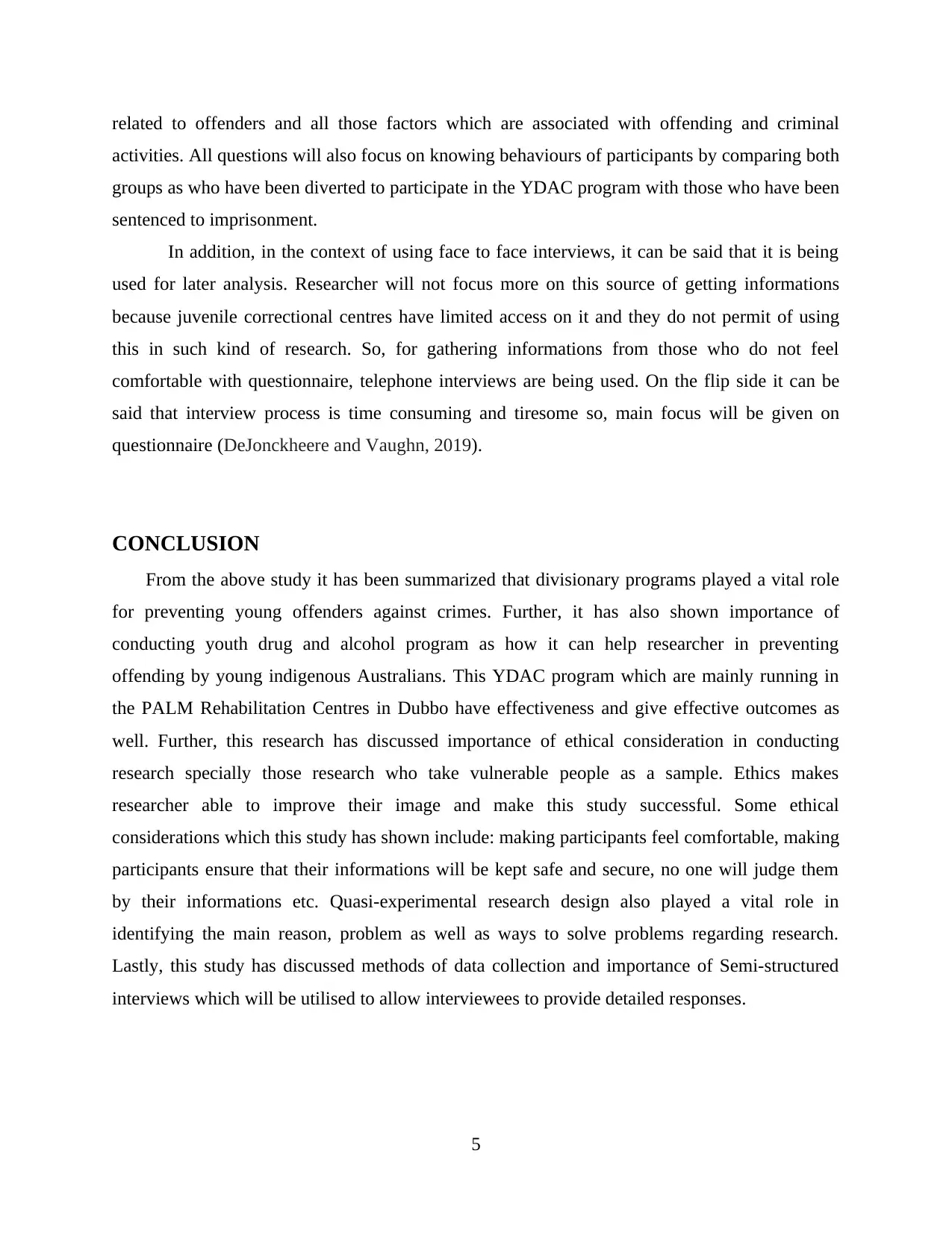
related to offenders and all those factors which are associated with offending and criminal
activities. All questions will also focus on knowing behaviours of participants by comparing both
groups as who have been diverted to participate in the YDAC program with those who have been
sentenced to imprisonment.
In addition, in the context of using face to face interviews, it can be said that it is being
used for later analysis. Researcher will not focus more on this source of getting informations
because juvenile correctional centres have limited access on it and they do not permit of using
this in such kind of research. So, for gathering informations from those who do not feel
comfortable with questionnaire, telephone interviews are being used. On the flip side it can be
said that interview process is time consuming and tiresome so, main focus will be given on
questionnaire (DeJonckheere and Vaughn, 2019).
CONCLUSION
From the above study it has been summarized that divisionary programs played a vital role
for preventing young offenders against crimes. Further, it has also shown importance of
conducting youth drug and alcohol program as how it can help researcher in preventing
offending by young indigenous Australians. This YDAC program which are mainly running in
the PALM Rehabilitation Centres in Dubbo have effectiveness and give effective outcomes as
well. Further, this research has discussed importance of ethical consideration in conducting
research specially those research who take vulnerable people as a sample. Ethics makes
researcher able to improve their image and make this study successful. Some ethical
considerations which this study has shown include: making participants feel comfortable, making
participants ensure that their informations will be kept safe and secure, no one will judge them
by their informations etc. Quasi-experimental research design also played a vital role in
identifying the main reason, problem as well as ways to solve problems regarding research.
Lastly, this study has discussed methods of data collection and importance of Semi-structured
interviews which will be utilised to allow interviewees to provide detailed responses.
5
activities. All questions will also focus on knowing behaviours of participants by comparing both
groups as who have been diverted to participate in the YDAC program with those who have been
sentenced to imprisonment.
In addition, in the context of using face to face interviews, it can be said that it is being
used for later analysis. Researcher will not focus more on this source of getting informations
because juvenile correctional centres have limited access on it and they do not permit of using
this in such kind of research. So, for gathering informations from those who do not feel
comfortable with questionnaire, telephone interviews are being used. On the flip side it can be
said that interview process is time consuming and tiresome so, main focus will be given on
questionnaire (DeJonckheere and Vaughn, 2019).
CONCLUSION
From the above study it has been summarized that divisionary programs played a vital role
for preventing young offenders against crimes. Further, it has also shown importance of
conducting youth drug and alcohol program as how it can help researcher in preventing
offending by young indigenous Australians. This YDAC program which are mainly running in
the PALM Rehabilitation Centres in Dubbo have effectiveness and give effective outcomes as
well. Further, this research has discussed importance of ethical consideration in conducting
research specially those research who take vulnerable people as a sample. Ethics makes
researcher able to improve their image and make this study successful. Some ethical
considerations which this study has shown include: making participants feel comfortable, making
participants ensure that their informations will be kept safe and secure, no one will judge them
by their informations etc. Quasi-experimental research design also played a vital role in
identifying the main reason, problem as well as ways to solve problems regarding research.
Lastly, this study has discussed methods of data collection and importance of Semi-structured
interviews which will be utilised to allow interviewees to provide detailed responses.
5
Paraphrase This Document
Need a fresh take? Get an instant paraphrase of this document with our AI Paraphraser
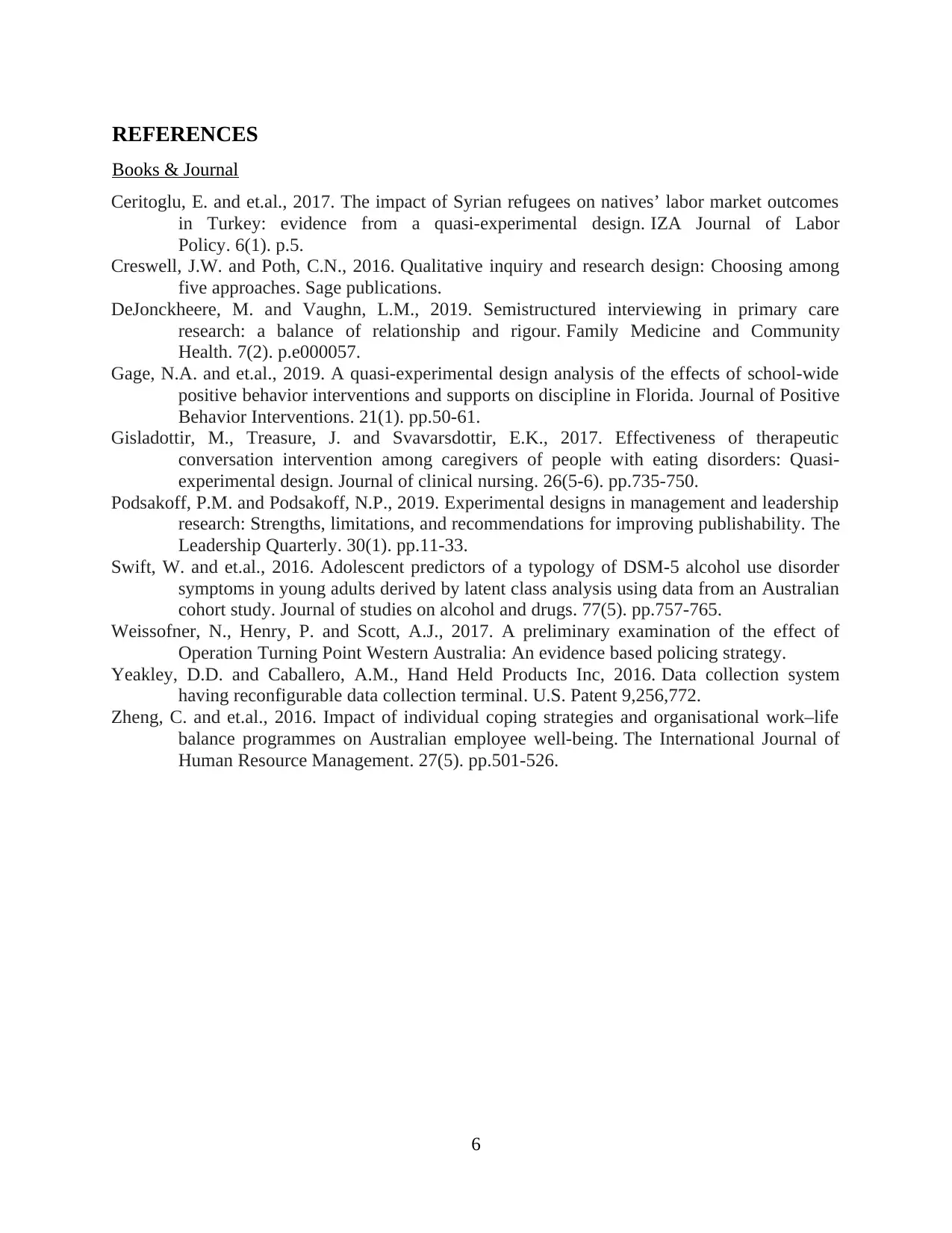
REFERENCES
Books & Journal
Ceritoglu, E. and et.al., 2017. The impact of Syrian refugees on natives’ labor market outcomes
in Turkey: evidence from a quasi-experimental design. IZA Journal of Labor
Policy. 6(1). p.5.
Creswell, J.W. and Poth, C.N., 2016. Qualitative inquiry and research design: Choosing among
five approaches. Sage publications.
DeJonckheere, M. and Vaughn, L.M., 2019. Semistructured interviewing in primary care
research: a balance of relationship and rigour. Family Medicine and Community
Health. 7(2). p.e000057.
Gage, N.A. and et.al., 2019. A quasi-experimental design analysis of the effects of school-wide
positive behavior interventions and supports on discipline in Florida. Journal of Positive
Behavior Interventions. 21(1). pp.50-61.
Gisladottir, M., Treasure, J. and Svavarsdottir, E.K., 2017. Effectiveness of therapeutic
conversation intervention among caregivers of people with eating disorders: Quasi‐
experimental design. Journal of clinical nursing. 26(5-6). pp.735-750.
Podsakoff, P.M. and Podsakoff, N.P., 2019. Experimental designs in management and leadership
research: Strengths, limitations, and recommendations for improving publishability. The
Leadership Quarterly. 30(1). pp.11-33.
Swift, W. and et.al., 2016. Adolescent predictors of a typology of DSM-5 alcohol use disorder
symptoms in young adults derived by latent class analysis using data from an Australian
cohort study. Journal of studies on alcohol and drugs. 77(5). pp.757-765.
Weissofner, N., Henry, P. and Scott, A.J., 2017. A preliminary examination of the effect of
Operation Turning Point Western Australia: An evidence based policing strategy.
Yeakley, D.D. and Caballero, A.M., Hand Held Products Inc, 2016. Data collection system
having reconfigurable data collection terminal. U.S. Patent 9,256,772.
Zheng, C. and et.al., 2016. Impact of individual coping strategies and organisational work–life
balance programmes on Australian employee well-being. The International Journal of
Human Resource Management. 27(5). pp.501-526.
6
Books & Journal
Ceritoglu, E. and et.al., 2017. The impact of Syrian refugees on natives’ labor market outcomes
in Turkey: evidence from a quasi-experimental design. IZA Journal of Labor
Policy. 6(1). p.5.
Creswell, J.W. and Poth, C.N., 2016. Qualitative inquiry and research design: Choosing among
five approaches. Sage publications.
DeJonckheere, M. and Vaughn, L.M., 2019. Semistructured interviewing in primary care
research: a balance of relationship and rigour. Family Medicine and Community
Health. 7(2). p.e000057.
Gage, N.A. and et.al., 2019. A quasi-experimental design analysis of the effects of school-wide
positive behavior interventions and supports on discipline in Florida. Journal of Positive
Behavior Interventions. 21(1). pp.50-61.
Gisladottir, M., Treasure, J. and Svavarsdottir, E.K., 2017. Effectiveness of therapeutic
conversation intervention among caregivers of people with eating disorders: Quasi‐
experimental design. Journal of clinical nursing. 26(5-6). pp.735-750.
Podsakoff, P.M. and Podsakoff, N.P., 2019. Experimental designs in management and leadership
research: Strengths, limitations, and recommendations for improving publishability. The
Leadership Quarterly. 30(1). pp.11-33.
Swift, W. and et.al., 2016. Adolescent predictors of a typology of DSM-5 alcohol use disorder
symptoms in young adults derived by latent class analysis using data from an Australian
cohort study. Journal of studies on alcohol and drugs. 77(5). pp.757-765.
Weissofner, N., Henry, P. and Scott, A.J., 2017. A preliminary examination of the effect of
Operation Turning Point Western Australia: An evidence based policing strategy.
Yeakley, D.D. and Caballero, A.M., Hand Held Products Inc, 2016. Data collection system
having reconfigurable data collection terminal. U.S. Patent 9,256,772.
Zheng, C. and et.al., 2016. Impact of individual coping strategies and organisational work–life
balance programmes on Australian employee well-being. The International Journal of
Human Resource Management. 27(5). pp.501-526.
6

⊘ This is a preview!⊘
Do you want full access?
Subscribe today to unlock all pages.

Trusted by 1+ million students worldwide

1
1 out of 10
Related Documents
Your All-in-One AI-Powered Toolkit for Academic Success.
+13062052269
info@desklib.com
Available 24*7 on WhatsApp / Email
![[object Object]](/_next/static/media/star-bottom.7253800d.svg)
Unlock your academic potential
Copyright © 2020–2025 A2Z Services. All Rights Reserved. Developed and managed by ZUCOL.





